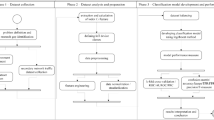Abstract
Safety of children is of utmost importance in any home environment. IoT when combined with machine learning is found to offer tremendous benefits in creating smart and safe homes to the society. The aim of this research is to, apply machine learning models, in order to detect the anomaly on the dataset gathered from three IoT devices. The environmental parameters for which the anomaly is detected are smoke emission, light illumination, LPG gas emission, CO emission, motion detection, humidity changes and temperature-level changes. The research makes use of three machine learning models namely K-Means clustering, Isolation Forest and Inter-Quartile Range to detect anomalies. In addition to that, it also uses Facebook Prophet Model to predict the daily trends in the data predicted by the three models. The evaluation of performance shows that the accuracy of predicting anomaly is greater for the Inter-quartile range model when compared with that of the remaining two machine learning models. The accuracy obtained by the IQR model is 99% whereas the models K-means and Isolation Forest render an accuracy of 94% each. The study also provides a scheme of a hardware as a part of the future work that could be implemented in order to implement child safety in a better way in the near future.





























Source Author
Similar content being viewed by others
References:
Kumar S, Tiwari P, Zymbler M (2019) Internet of Things is a revolutionary approach for future technology enhancement: a review. J Big Data. https://doi.org/10.1186/s40537-019-0268-2
Hasan M, Islam MdM, Zarif MdII et al (2019) Attack and anomaly detection in IoT sensors in IoT sites using machine learning approaches. Internet Things 7(100059):1–14
Liu X, Liu Y, Liu A, Yang LT (2018) Defending on–off attacks using light probing messages in smart sensors for industrial communication systems. IEEE Trans Ind Inf 14(9):3801–3811
Diro AA, Chilamkurti N (2018) Distributed attack detection scheme using deep learning approach for internet of things. Future Gen Comput Syst 82:761–768
Akash AB (2017) IoT-based temperature and humidity monitoring system for agriculture. Int J Innov Res Sci Eng Technol 6(7):12756–12761
Agarwal P, Ravikumar R, Sabarish G et al (2020) Survey on child safety wearable device using IoT sensors and cloud computing. Int J Innov Sci Res Technol 5(2):1055–1062
Krishnamurthi R, Kumar A, Gopinathan D et al (2020) An overview of IoT sensor data processing, fusion, and analysis techniques. Sensors 20(6076):1–23
Girija C, Harshalatha H, Pushpalatha HP, and Shires AG (2018) “Internet of Things (IOT) based weather monitoring system”. International Journal of Engineering Research & Technology (IJERT)–NCESC–2018 Conference Proceedings, SI-6(13), 1–4
Islam MdZ, Based MdA, Rahman MdM (2021) IoT-based temperature and humidity real-time monitoring and reporting system for CoVid-19 pandemic period. Int J Sci Res Eng Develop 4(1):1214–1221
Rahman R, Ab H, R’ah U, Ahmad S (2020) IoT based temperature and humidity monitoring framework. Bull Electrical Eng Inform 9(1):229–237
Gomes JBA, Rodrigues JJPC, Rabelo RAL, Kumar N, Kozlov S (2019) IoT-enabled gas sensors: technologies, applications, and opportunities. J Sens Actuator Netw 8(57):1–29
Imade S, Rajmanes P, Gavali A, Nayakwadi VN (2018) Gas leakage detection and smart alerting system using IoT. Int J Innov Res Studies 8(2):291–298
Lavanya V, Meenambigai C, Suriyaa M and Kavya S (2019) “Child safety wearable device”. Int J Comput Sci Eng (SSRG-IJCSE), SI(2019), 1–5
Priyanka MN, Murugan S, Srinivas KNH, Sarveswararao TDS, Kumari EK (2019) Smart IOT device for child safety and tracking. Int J Innov Technol Explor Eng (IJITEE) 8(8):1791–1795
Manikkannan D, Azarudeen J, Reddy PS, Kumar SP (2020) An integrated child safety monitoring device using WSN technology. IJESC 10(4):25176–25179
Senthamilarasi N, Bharathi ND, Ezhilarasi D, Sangavi RB (2019) Child safety monitoring system based on IoT. J Phys Conf Ser 1362(012012):1–8
Espinosa AV, Lopez JL, Mata FM, Estevez ME (2021) Application of IoT in healthcare: keys to implementation of the sustainable development goals. Sensors 21(2330):1–37
Gao R, Zhang T, Sun S, Liu Z (2019) Research and improvement of isolation forest in detection of local anomaly points. J Phys IOP Conf. Ser. 1237(052023):1–7
Ramani V, Razia S (2020) Comparative evaluation of supervised and unsupervised algorithms for intrusion detection. Int J Adv Trends Comput Sci Eng 9(4):4834–4843
Santis RB, Costa MA (2020) Extended isolation forests for fault detection in small hydroelectric plants. Sustainability 12(6421):1–16
Stafford G (2021) Environmental sensor telemetry data, Retrieved on 10th March 2021 Accessed from Environmental Sensor Telemetry Data | Kaggle
Jeong Y-S, Jeon M, Park JH et al (2021) Machine-learning-based approach to differential diagnosis in tuberculous and viral meningitis. Infect Chemother J 53(1):53–62
Heigl M, Anand KA, Urmann A et al (2021) On the improvement of the isolation forest algorithm for outlier. Detect Streaming Data Electron 10(1534):1–26
Author information
Authors and Affiliations
Corresponding author
Additional information
Publisher's Note
Springer Nature remains neutral with regard to jurisdictional claims in published maps and institutional affiliations.
Rights and permissions
About this article
Cite this article
Shenbagalakshmi, V., Jaya, T. Application of machine learning and IoT to enable child safety at home environment. J Supercomput 78, 10357–10384 (2022). https://doi.org/10.1007/s11227-022-04310-z
Accepted:
Published:
Issue Date:
DOI: https://doi.org/10.1007/s11227-022-04310-z




